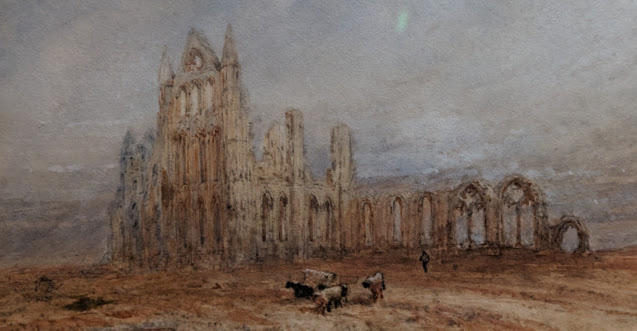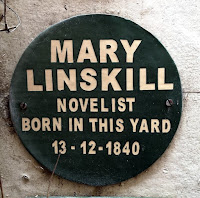The most obvious connection is, of course, Bram Stoker's Dracula, and this on its own is rather thrilling. I have only recently become interested in the Gothic and Horror genre, so I bought myself a beautifully illustrated edition, in the Whitby Bookshop, and I'm looking forward to reading this.
I'm enjoying the descriptions of Whitby in the novel "an animal resembling a large dog is seen leaping ashore when the ship runs aground at Whitby", and can now understand why the town is such a magnet for Bram Stoker fans.
Elizabeth Gaskell's Sylvia's Lovers is set in the fictional town of Monkshaven, or Whitby, in 1790. The whaling industry is in full swing and this forms the backdrop for a romantic novel that charts the exploits of the press gang during the French Wars, as two men attempt to win the favour of a beautiful young woman.
The inspiration for Sylvia's Lovers happened when Mrs Gaskell stayed at No.1 Abbey Terrace for a brief visit in 1859. This was the foundation for her description of Whitby. The home belonged to the "Railway King", George Hudson, who had grand visions for Whitby as a tourist centre.
One of the most famous poems connected with Whitby Abbey is Caedmon's Hymn. If Bede's account is correct, the poem was composed between 658 and 680 and has a claim to being the oldest surviving English poem. Caedmon was an illiterate cow-herder employed at the monastery of Whitby who miraculously recited a Christian song of praise in Old English verse.
Nū scylun hergan hefaenrīcaes Uard,
metudæs maecti end his mōdgidanc,
uerc Uuldurfadur, suē hē uundra gihuaes,
ēci dryctin ōr āstelidæ
hē ǣrist scōp aelda barnum
heben til hrōfe, hāleg scepen.
Thā middungeard moncynnæs Uard,
eci Dryctin, æfter tīadæ
fīrum foldu, Frēa allmectig.
Now [we] shall honour / heaven-kingdom's Ward,
the measurer's might / and his mind-plan,
the work of the Glory-father / as he of each wonder,
eternal lord, / the origin established;
he first created / for the children of men
heaven for a roof, / holy shaper.
Then Middle-earth / mankind's Ward,
eternal Lord, / after created,
the lands for men, / Lord almighty.
Her novels fell out of favour after the Second World War, but when they were in print, they did a great deal to promote Whitby as a visitor destination.
I've not read any of Linskill's work, but reading about her makes me keen to try her best received novel The Haven Under the Hill.
Storm Jameson was born in 1891 in Whitby and published 86 novels and a number of novellas and journalistic work. I have read her most famous novel Company Parade and am now keen to read more of her work. One of her best known quotes feels prophetic, given that she died in 1986 and before the computer and mobile phone were ubiquitous “we need the slower and more lasting stimulus of solitary reading as a relief from the pressure on eye, ear and nerves of the torrent of information and entertainment pouring from ever-open electronic jaws. It could end by stupefying us.”
Something that did surprise me is that there is very little children’s literature set in the area. The closest I can get is Edith Nesbit's The Railway Children, set on the North Yorkshire Moors, but so far nothing of interest set in Whitby. I will keep on looking into this.
Finally, a modern author whose descriptions of Whitby inspired me to visit is Jan Durham. Her very light and enjoyable cosy crime novels are charming and create a very credible description of the town. I loved following her footsteps through Whitby, in her Kipper Cottage novels. The real Whitby feels very similar to her fictionalised descriptions.




